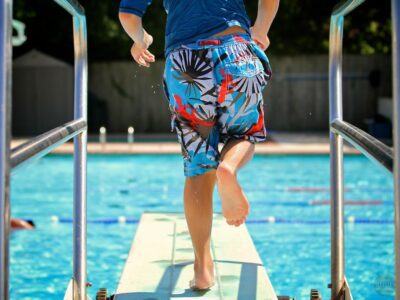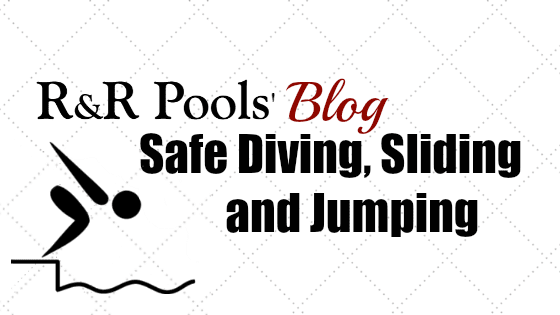Summertime means fun for kids. Thrill and adventure awaits them at every turn. But it’s the thrill of diving into a pool or sliding into the water that prompts us to send out a reminder on safe diving and sliding this week as we dig further into our Safety Month. Below is a piece from the National Spa & Pool Institute regarding the sensible way to enjoy your pool.
Safe Diving and Sliding
Do not allow any diving or headfirst entry into any pool until you are sure the pool is designed for diving and meets all standards for diving pools. Consult your pool builder if you have any doubts. Do not allow diving into a pool, or any part of the pool, that is not deep enough for diving. It is recommended that “No Diving” signs be placed at all areas of the pool where diving is not appropriate. The chief danger for divers or headfirst sliders is serious spinal injury. A person may hit their heads against the bottom or side of the pool or against some object or person. Injuries to the spinal cord may result, causing temporary or permanent paralysis or death. Never use alcohol while diving or swimming. Serious spinal injuries can occur, even at very slow speeds if the head strikes firmly against the pool bottom or side, the spine cannot absorb as great an impact as the skull can, especially if the head has been fixed against an immovable object.
If your pool has been designed for diving, you must be able to identify “real divers” and areas or locations where diving is permitted. As with swimming, the most practical definition of a diver might be someone who has achieved minimum safe diving skills through training in a certified course of instruction. People may overestimate their abilities and claim to be “divers” so use extreme caution.
Some Do’s and Don’t’s of Diving:
DO:
- Do know the shape of the pool bottom and the water depth before you dive or slide headfirst.
- Do plan your path to avoid submerged obstacles, surface objects or other swimmers.
- Do hold your head up, arms up, and STEER UP with your hands
- Do keep arms extended and head and hands up
- Do practice carefully before you dive or slide headfirst.
- Do test the diving board for its spring before using.
- Do remember that when you dive down, you must steer up
- Do dive straight ahead – not off the side of a diving board
DON’T
- Don’t drink and dive
- Don’t dive into an above ground pool
- Don’t dive into a pool not meeting a “diving pool” standard
- Don’t dive or slide headfirst in the shallow part of the pool
- Don’t dive across the narrow part of pools
- Don’t run and dive
- Don’t dive from any place that is not specifically designed for diving
- Don’t engage in horseplay on diving or sliding equipment
- Don’t use diving equipment as a trampoline
- Don’t do a back dive; backyard pools are not built for this dangerous dive
- Don’t try fancy dives; keep the dives simple
- Don’t dive or slide headfirst at or through objects such as inner tubes
- Don’t put diving or sliding equipment on a pool that wasn’t designed for it
- Don’t swim or dive alone
- Don’t dive into unfamiliar bodies of water.
Investigations have shown that many diving and headfirst sliding accidents have resulted when people were using the pool under the influence of alcohol or drugs.
If you use a pool slide, you must have a landing area with adequate clearance over the deck or the edge of the pool (the coping) and with appropriate depth of water. Follow the slide manufacturer’s specifications regarding clearance and depth, installation instructions and proper use.
If headfirst slides are to be attempted, the pool slide must exit into deep water. There are only two proper ways to use a slide – sitting, going down feet first, and lying flat on your belly, headfirst, pursuant to 16 CFR CH. II (1-1-93 Edition) U.S. Consumer Product Safety Commission, Part 1207 Safety Standard for Swimming Pool Slides. All other methods of using a slide are dangerous and present a risk of serious injury.
When you are writing your “pool rules”, consider who will be using your slide and how. Enforce proper use of the slide.
Under all circumstances you should prohibit:
- Any slide other than sitting, feet first or flat on the belly, headfirst
- Headfirst entries from a slide that exits into shallow water
- Horseplay
- Any slide entries by non-swimmers into deep water, to protect them from drowning
- Standing on the top of a slide or outside the guide rails
- Jumping from a slide
- Diving from a slide
- Sliding into areas with submerged obstacles, surface objects or other swimmers
Jumping
Jumping incorrectly into shallow water can be dan gerous, and injuries, such as a broken leg, can occur if you hit bottom with a sufficient force. Before jumping, know the depth of the water and look out for any submerged obstacles, surface objects or other swimmers. Always jump directly forward from the edge of the pool or the diving board.
gerous, and injuries, such as a broken leg, can occur if you hit bottom with a sufficient force. Before jumping, know the depth of the water and look out for any submerged obstacles, surface objects or other swimmers. Always jump directly forward from the edge of the pool or the diving board.
Certified swimming instructors can teach you how to jump correctly into a pool. This is especially important for beginning swimmers or children and should be part of their water safety instruction.



3 Comments
Kristina
I jumped incorrectly In the shallow end of my friends pool and but my back on the bottom of the pool. The pain is getting worse as the day goes on. I also have a headache
Kara Redden
Hi Kristina,
You should head in immediately to your local emergency room for x-rays to see if any damage has been done and for a professional medical opinion.
Ivon
Is it safe to use a slide on the pool wearing a diving masks?